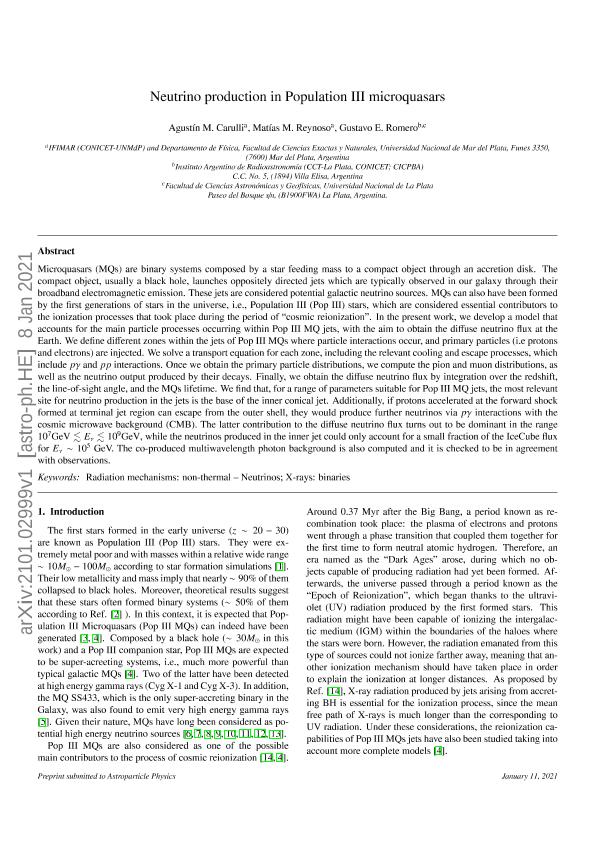Artículo
Neutrino production in Population III microquasars
Fecha de publicación:
03/2021
Editorial:
Elsevier Science
Revista:
Astroparticle Physics
ISSN:
0927-6505
Idioma:
Inglés
Tipo de recurso:
Artículo publicado
Clasificación temática:
Resumen
Microquasars (MQs) are binary systems composed by a star feeding mass to a compact object through an accretion disk. The compact object, usually a black hole, launches oppositely directed jets which are typically observed in our galaxy through their broadband electromagnetic emission. These jets are considered potential galactic neutrino sources. MQs can also have been formed by the first generations of stars in the universe, i.e., Population III (Pop III) stars, which are considered essential contributors to the ionization processes that took place during the period of ãcosmic reionizationå. In the present work, we develop a model that accounts for the main particle processes occurring within Pop III MQ jets, with the aim to obtain the diffuse neutrino flux at the Earth. We define different zones within the jets of Pop III MQs where particle interactions occur, and primary particles (i.e protons and electrons) are injected. We solve a transport equation for each zone, including the relevant cooling and escape processes, which include pγ and pp interactions. Once we obtain the primary particle distributions, we compute the pion and muon distributions, as well as the neutrino output produced by their decays. Finally, we obtain the diffuse neutrino flux by integration over the redshift, the line-of-sight angle, and the MQs lifetime. We find that, for a range of parameters suitable for Pop III MQ jets, the most relevant site for neutrino production in the jets is the base of the inner conical jet. Additionally, if protons accelerated at the forward shock formed at terminal jet region can escape from the outer shell, they would produce further neutrinos via pγ interactions with the cosmic microwave background (CMB). The latter contribution to the diffuse neutrino flux turns out to be dominant in the range 107GeV≲Eν≲109GeV, while the neutrinos produced in the inner jet could only account for a small fraction of the IceCube flux for Eν∼105 GeV. The co-produced multiwavelength photon background is also computed and it is checked to be in agreement with observations.
Palabras clave:
BINARIES
,
NON-THERMAL – NEUTRINOS
,
RADIATION MECHANISMS
,
X-RAYS
,
COVID-19
Archivos asociados
Licencia
Identificadores
Colecciones
Articulos(IFIMAR)
Articulos de INST.DE INVESTIGACIONES FISICAS DE MAR DEL PLATA
Articulos de INST.DE INVESTIGACIONES FISICAS DE MAR DEL PLATA
Citación
Carulli, Agustín Matías; Reynoso, Matias Miguel; Romero, Gustavo Esteban; Neutrino production in Population III microquasars; Elsevier Science; Astroparticle Physics; 128; 3-2021; 1-20
Compartir
Altmétricas




